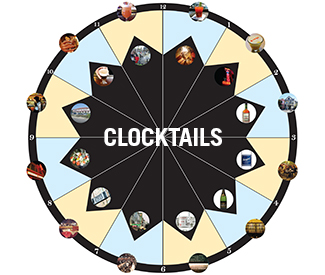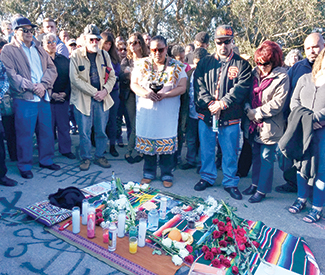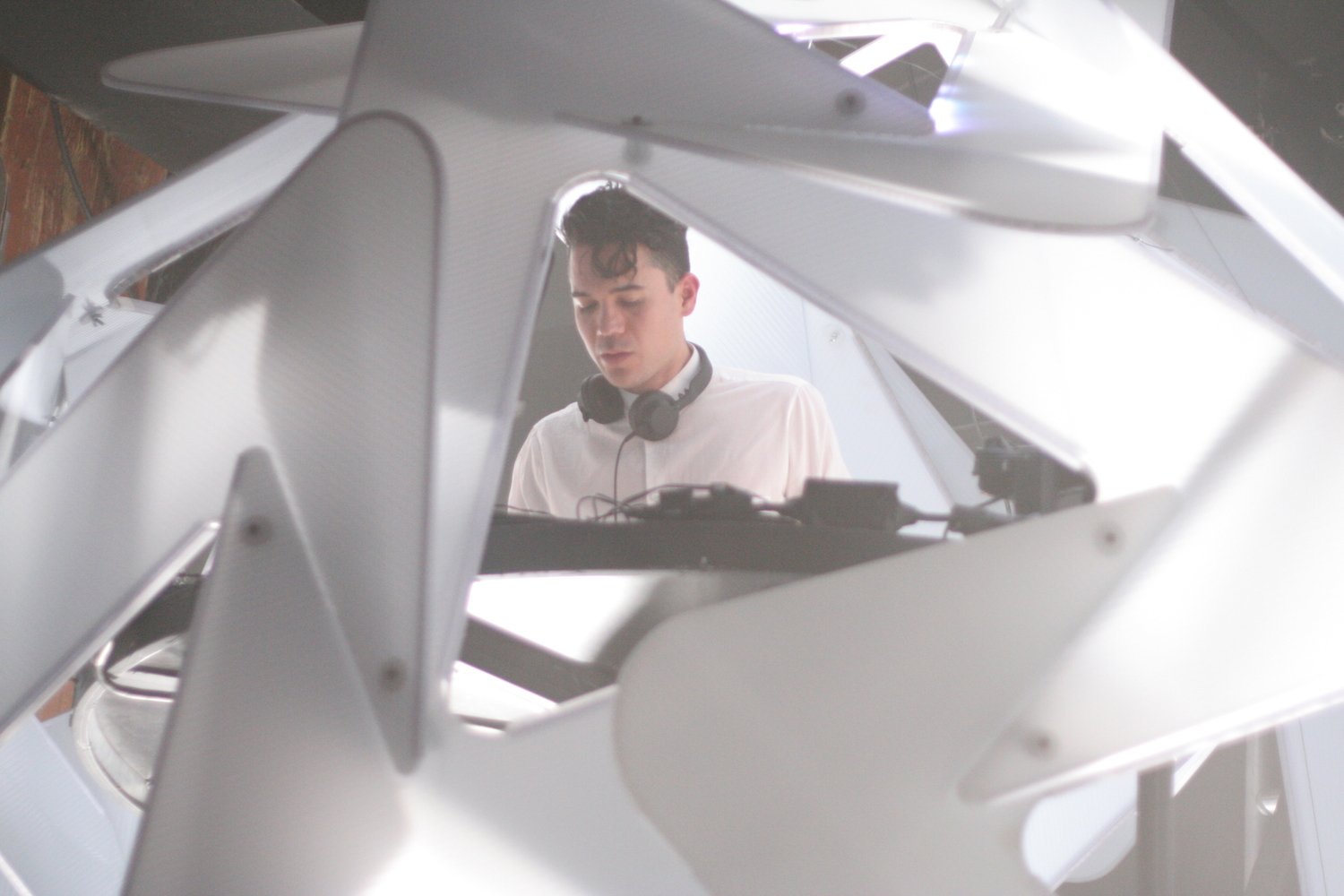Stage listings are compiled by Guardian staff. Performance times may change; call venues to confirm. Reviewers are Robert Avila, Rita Felciano, and Nicole Gluckstern. Submit items for the listings at listings@sfbg.com.
THEATER
OPENING
The Homosexuals New Conservatory Theatre Center, Decker Theatre, 25 Van Ness, SF; www.nctcsf.org. $25-45. Previews Fri/16-Sat/17 and May 21 and 23, 8pm; Sun/18, 2pm. Opens May 24, 8pm. Runs Wed-Sat, 8pm; Sun, 2pm. Through June 28. New Conservatory Theatre Center performs Philip Dawkins’ play about a young man struggling with his identity amid a new group of friends.
BAY AREA
The Crazed Berkeley City Club, 2315 Durant, Berk; www.centralworks.org. $15-28. Previews Thu/15-Fri/16, 8pm. Opens Sat/17, 8pm. Runs Thu-Sat, 8pm; Sun, 5pm. Through June 23. Central Works performs Sally Dawidoff’s play, based on Ha Jin’s novel about coming of age in Communist China.
The Intelligent Homosexual’s Guide to Capitalism and Socialism with a Key to the Scriptures Berkeley Repertory Theatre, Roda Theatre, 2015 Addison, Berk; www.berkeleyrep.org. $14.50-89. Previews Fri/16-Sat/17 and Tue/20, 7:30pm; Sun/18, 7pm. Opens May 21, 7:30pm. Runs Tue, Thu-Sat, 7:30pm (also May 29, June 26, and all Saturdays in June, 2pm); Wed and Sun, 7pm (also Sun, 2pm). Through June 29. Berkeley Rep performs the West Coast premiere of Tony Kushner’s latest play.
The 25th Annual Putnam County Spelling Bee Lesher Center for the Arts, 1601 Civic, Walnut Creek; www.centerrep.org. $37-65. Previews Fri/16-Sat/17, 8pm; Sun/18, 2:30pm. Opens Tue/20, 7:30pm. Runs Wed, 7:30pm; Thu-Sat, 8pm (also June 7, 14, 21, 2:30pm); Sun, 2:30pm. Through June 21. Center REP performs the Tony-winning musical by William Finn and Rachel Sheinkin.
ONGOING
“Best of PlayGround 18” Thick House, 1695 18th St, SF; www.playground-sf.org. $22-55 (all-fest pass, $60-75). Thu-Sat, 8pm; Sun, 7pm. Through May 25. Short plays and musicals by Bay Area writers.
Chasing Mehserle Intersection for the Arts, 925 Mission, SF; chasingmehserle.brownpapertickets.com. $25. Thu-Sun, 8pm. Through May 24. Also May 29-31, 8pm, $15-25, Z Space, 450 Florida, SF; www.zspace.org. Intersection for the Arts, Campo Santo, and the Living Word Project present Chinaka Hodge’s performance piece about Oakland in the aftermath of the Oscar Grant killing.
Communiqué N°10 Exit on Taylor, 277 Taylor, SF; www.cuttingball.com. $10-50. Thu, 7:30; Fri-Sat, 8pm (also Sat, 2pm); Sun, 5pm. Through May 25. Amid a fractious band of young rebels from the urban underclass and ongoing rioting in the streets, a young immigrant named Hassan (Damien Seperi) searches for the man who killed his 16-year-old brother. French playwright Samuel Gallet’s Communiqué N°10 draws immediate inspiration from the Paris riots of 2005, but the tinder box of extreme inequality and anti-immigrant policies are hardly a French monopoly (indeed, the standoff last year between immigrant rights demonstrators and French police following the deportation of a Roma student, snatched off a school bus in front of her classmates, sounds all too familiar to Americans living through Obama’s unprecedented wave of deportations and incarcerations of undocumented people and the popular protest rising against it). Cutting Ball Theater’s US premiere of Gallet’s play, however, strains after its subject, timely though it is. Presented in association with Golden Thread Productions as part of the second biennial Des Voix&ldots; festival of new French plays and cinema, director and translator Rob Melrose’s production sets the action on a spare set (designed by Michael Locher) ringed by a two-tier framework of metal piping, about which some of the seven-member cast climb and roost. But the sparse setting is in fact overwhelmed with altogether too much stage business, including Emma Jaster’s somewhat labored choreography and Cliff Caruthers’ often distracting soundscape, which only detracts from the already difficult-to-follow plot points and further undermines an ensemble that never really coheres. Add to this contrived dialogue such as Hassan’s retort to having his picture snapped by love-interest Marlene (Maura Halloran) — “Images. We never know what purposes they serve in the end” — and what should be a tense and dynamic drama instead becomes a dreary, vaguely didactic ball of confusion. (Avila)
“DIVAfest” Exit Theatre, 156 Eddy, SF; www.divafest.info. Prices and showtimes vary. Through May 24. This 13th annual festival celebrates the work of women artists, with performances including the premiere of Rat Girl (adapted from the memoir by rocker Kristin Hersh), Margery Fairchild’s ballet comedy The Pas De Quatre, a reading by acclaimed poet Diane di Prima, and more.
Dracula Shelton Theater, 533 Sutter, SF; sfdracula.blogspot.com. $35. Thu-Sat, 8pm. Through May 31. Kellerson Productions presents a new adaptation of the Bram Stoker classic.
Du Barry Was a Lady Eureka Theatre, 215 Jackson, SF; www.42ndstmoon.org. $25-75. Wed/14-Thu/15, 7pm; Fri/16, 8pm; Sat/17, 6pm (also Sat/17, 1pm); Sun/18, 3pm. 42nd Street Moon presents Cole Porter’s saucy musical comedy, with comedian and writer Bruce Vilanch starring.
Feisty Old Jew Marsh San Francisco Main Stage, 1062 Valencia, SF; www.themarsh.org. $25-100. New performance schedule: Sat-Sun, 5pm. Extended through July 13. Charlie Varon performs his latest solo show, a fictional comedy about “a 20th century man living in a 21st century city.”
Foodies! The Musical Shelton Theater, 533 Sutter, SF; www.foodiesthemusical.com. $32-34. Fri-Sat, 8pm. Open-ended. AWAT Productions presents Morris Bobrow’s musical comedy revue all about food.
Lovebirds Marsh San Francisco Studio, 1062 Valencia, SF; www.themarsh.org. $20-100. Fri, 8pm; Sat, 8:30pm. Through May 31. Award-winning solo theater artist Marga Gomez brings her hit comedy back for a limited run before taking it to New York in June.
Pearls Over Shanghai Hypnodrome Theatre, 575 10th St, SF; www.thrillpeddlers.com. $30-35. Thu-Sat, 8pm. Through May 31. Five years ago, Thrillpeddlers breathed new life into a glitter-dusted piece of Sixties flotsam, beautifully reimagining the Cockettes’ raunchy mock-operetta Pearls Over Shanghai (in collaboration with several surviving members of San Francisco’s storied acid-drag troupe) and running it for a whopping 22 months. Written by Cockette Link Martin as a carefree interpretation of a 1926 Broadway play, the baldly stereotyped Shanghai Gesture, it was the perfectly lurid vehicle for irreverence in all directions. It’s back in this revival, once again helmed by artistic director Russell Blackwood with musical direction by Cockette and local favorite Scrumbly Koldewyn. But despite the frisson of featuring some original-original cast members — including “Sweet Pam” Tent (who with Koldewyn also contributes some new dialogue) and Rumi Missabu (regally reprising the role of Madam Gin Sling) — there’s less fire the second time around as the production straddles the line between carefully slick and appropriately sloppy. Nevertheless, there are some fine musical numbers and moments throughout. Among these, Zelda Koznofsky, Birdie-Bob Watt, and Jesse Cortez consistently hit high notes as the singing Andrews Sisters-like trio of Americans thrown into white slavery; Bonni Suval’s Lottie Wu is a fierce vixen; and Noah Haydon (as the sultry Petrushka) is a class act. Koldewyn’s musical direction and piano accompaniment, meanwhile, provide strong and sure momentum as well as exquisite atmosphere. (Avila)
Romeo and Juliet Phoenix Theatre, 414 Mason, Ste 601, SF; www.eventbrite.com. $20. Thu-Sat, 8pm (also May 24, 3pm). Through May 24. Ninjaz of Drama perform Shakespeare’s tragic romance.
Seminar San Francisco Playhouse, 450 Post, Second Flr, SF; www.sfplayhouse.org. $20-100. Tue-Thu, 7pm; Fri-Sat, 8pm (also Sat, 3pm); Sun/18, June 1, and 8, 2pm. Through June 14. San Francisco Playhouse performs Theresa Rebeck’s biting comedy.
Shit & Champagne Rebel, 1772 Market, SF; shitandchampagne.eventbrite.com. $25. Fri-Sat, 8pm. Open-ended. D’Arcy Drollinger is Champagne White, bodacious blond innocent with a wicked left hook in this cross-dressing ’70s-style white-sploitation flick, played out live on Rebel’s intimate but action-packed barroom stage. Written by Drollinger and co-directed with Laurie Bushman (with high-flying choreography by John Paolillo, Drollinger, and Matthew Martin), this high-octane camp send-up of a favored formula comes dependably stocked with stock characters and delightfully protracted by a convoluted plot (involving, among other things, a certain street drug that’s triggered an epidemic of poopy pants) — all of it played to the hilt by an excellent cast that includes Martin as Dixie Stampede, an evil corporate dominatrix at the head of some sinister front for world domination called Mal*Wart; Alex Brown as Detective Jack Hammer, rough-hewn cop on the case and ambivalent love interest; Rotimi Agbabiaka as Sergio, gay Puerto Rican impresario and confidante; Steven Lemay as Brandy, high-end calf model and Champagne’s (much) beloved roommate; and Nancy French as Rod, Champagne’s doomed fiancé. Sprawling often literally across two buxom acts, the show maintains admirable consistency: The energy never flags and the brow stays decidedly low. (Avila)
Sleeping Cutie: A Fractured Fairy Tale Musical Thick House, 1695 18th St, SF; sleepingcutiemusical.tix.com. $30-40. Extended run: Sat/10, May 12-14 and 19-21, 8pm; Sun/11, 2pm. Off a Cliff Productions and PlayGround present Diane Sampson and Doug Katsaros’ world-premiere musical.
The Speakeasy Undisclosed location (ticket buyers receive a text with directions), SF; www.thespeakeasysf.com. $70 (gambling chips, $5-10 extra; after-hours admission, $10). Thu-Sat, 7:40, 7:50, and 8pm admittance times. Extended through May 24. Boxcar Theater’s most ambitious project to date is also one of the more involved and impressively orchestrated theatrical experiences on any Bay Area stage just now. An immersive time-tripping environmental work, The Speakeasy takes place in an “undisclosed location” (in fact, a wonderfully redesigned version of the company’s Hyde Street theater complex) amid a period-specific cocktail lounge, cabaret, and gambling den inhabited by dozens of Prohibition-era characters and scenarios that unfold around an audience ultimately invited to wander around at will. At one level, this is an invitation to pure dress-up social entertainment. But there are artistic aims here too. Intentionally designed (by co-director and creator Nick A. Olivero with co-director Peter Ruocco) as a fractured super-narrative — in which audiences perceive snatches of overheard stories rather than complete arcs, and can follow those of their own choosing — there’s a way the piece becomes specifically and ever more subtly about time itself. This is most pointedly demonstrated in the opening vignettes in the cocktail lounge, where even the ticking of Joe’s Clock Shop (the “cover” storefront for the illicit 1920s den inside) can be heard underscoring conversations (deeply ironic in historical hindsight) about war, loss, and regained hope for the future. For a San Francisco currently gripped by a kind of historical double-recurrence of the roaring Twenties and dire Thirties at once, The Speakeasy is not a bad place to sit and ponder the simulacra of our elusive moment. (Avila)
The Suit ACT’s Geary Theater, 415 Geary, SF; www.act-sf.org. $20-120. Wed/14-Sat/17, 8pm (also Wed/14 and Sat/17, 2pm); Sun/18, 1pm. ACT performs Peter Brook, Marie Hélène Estienne, and Franck Krawcyzk’s music-infused drama about betrayal and resentment adapted from the short story by South African author Can Themba.
Tipped & Tipsy Marsh Studio Theater, 1062 Valencia, SF; www.themarsh.org. $20-50. Sat/17, 5pm. Last fall’s San Francisco Fringe Festival began on a high note with Jill Vice’s witty and deft solo, Tipped & Tipsy, and the Best of Fringe winner is now enjoying another round at solo theater outpost the Marsh. Without set or costume changes, Vice (who developed the piece with Dave Dennison and David Ford) brings the querulous regulars of a skid-row bar to life both vividly and with real quasi-Depression-Era charm. She’s a protean physical performer, seamlessly inhabiting the series of oddball outcasts lined up each day at Happy’s before bartender Candy — two names as loaded as the clientele. After some hilarious expert summarizing of the dos and don’ts of bar culture, a story unfolds around a battered former boxer and his avuncular relationship with Candy, who tries to cut him off in light of his clearly deteriorating health. Her stance causes much consternation, and even fear, in his barfly associates, while provoking a dangerous showdown with the bar’s self-aggrandizing sleazeball owner, Rico. With a love of the underdog and strong writing and acting at its core, Tipsy breezes by, leaving a superlative buzz. (Avila)
“Des Voix: Found in Translation Biennial 2014” Various venues, SF; www.desvoixfestival.com. Prices vary. Through May 25. In addition to Communiqué N°10 (listed above), this festival of contemporary French playwrights and cinema includes four new play translations, a “New Play Nightclub,” film screenings, and more. Presented by Playwrights Foundation, Tides Theatre, Cutting Ball Theater, French International School, and the French Consulate of San Francisco.
Waxing West Brava Theater Center, 2781 24th St, SF; www.brava.org. $20. Thu/15-Sat/17, 8pm; Sun/18, 3pm. Romanian-born American playwright Saviana Stanescu’s 2007 comedy channels real-world angst and dislocation in its sly story of an independent-minded Romanian woman who, after arriving in New York as a mail-order bride, becomes a wax-wielding beautician and pastime kleptomaniac, haunted in her sleep by the vampire spirits of Nicolae and Elena Ceaucescu. In a deal brokered by her mother (Catz Forsman in old-world head scarf), 32-year-old Daniela (a serenely offbeat Beatrice Basso) leaves her family home in Bucharest, and an uncertain future in Romania, for a boyish Manhattan computer programmer named Charlie (a sympathetic, physically comical Jon Deline of local clown troupe Pi). Charlie is kind but noncommittal, having had no say in the arrangement initiated by his late interfering mother. Indeed, Charlie’s lesbian sister (Molly Shaiken) is far more interested in bedding Daniela, and courts her amid wine and waxings. Daniela’s only real friend ends up being a homeless and sickly ex-Yugoslav philosopher named Uros (Sam Coughlin, who doubles as Daniela’s brother Elvis), obsessed with pursuing the origins of the ancient Mesopotamian epic of Gilgamesh. Banking East and West throughout — in discretely titled scenes that hop between Bucharest and New York City over a 17-month period from 2000 to 2001 — Daniela’s every step comes dogged by a sarcastic pair of commentators, namely Romania’s former dictators, Nicolae Ceaucescu (a comically wimpish Forsman) and wife Elena (a pants-wearing Shaiken, in a heavily accented jewel of a performance), here reduced (elevated?) to blood-sucking zombies by Daniela’s fevered imagination. The current lurching production from Brava! For Women in the Arts and RasaNova Theater benefits from a quirky energy throughout, although director Vidhu Singh’s respectable cast had not fully cohered as of opening night, and there are plenty of rough patches. The stage is not always well lit and the action comes erratically blocked, for instance — although one wacky burst of physicality is also a highlight, as mismatched couple Daniela and Charlie engage in some idiosyncratic foreplay known as “the turkey game.” And if the production wanders in search of a clear course, that’s at least not entirely out of place with the play’s restless but good-humored emphasis on everyone’s search for an anchor in the 21st-century West. (Avila)
The World’s Funniest Bubble Show Marsh San Francisco, 1062 Valencia, SF; www.themarsh.org. $8-11. Sun, 11am. Extended through May 25. The popular, kid-friendly show by Louis Pearl (aka “The Amazing Bubble Man”) returns to the Marsh.
BAY AREA
The Color Purple Hillbarn Theatre, 1285 East Hillsdale, Foster City; www.hillbarntheatre.org. $23-38. Thu-Sat, 8pm; Sun, 2pm. Through June 1. Hillbarn Theatre closes its 73rd season with the musical adaptation of Alice Walker’s classic novel.
Geezer Marsh Berkeley, 2120 Allston, Berk; www.themarsh.org. $25-50. New show schedule: Wed, 8pm; Sat, 3pm. Extended through May 24. Geoff Hoyle moves his hit comedy about aging to the East Bay.
The Letters Harry’s UpStage, Aurora Theatre Company, 2081 Addison, Berk; www.auroratheatre.org. $28-32. Wed-Sat, 8pm; Sun, 2pm. Through June 1. American playwright John W. Lowell’s The Letters harkens back to Stalinist days and some unspecified ministry, where a dutiful staff goes about censoring the personal and openly homoerotic correspondence of an iconic Russian composer (Tchaikovsky). Directed by Mark Jackson for Aurora Theater’s new upstairs black box, the two-hander unfolds in the small but tidy and dignified office belonging to the ministry’s director (an imposing Michael Ray Wisely). He has summoned one of his employees, a widow named Anna (a taut Beth Wilmurt), for reasons not immediately clear to her or us. A careful dance around a minefield of protocol, sexual innuendo, and hidden agendas ensues, as a dangerous and deadly scandal surrounding the aforementioned letters makes itself felt. Given the Ukraine crisis, the ramping up of Cold War II, and Russia’s increasing authoritarianism — including its new law against homosexual “propagandizing” in the cultural realm, and a Ministry of Culture vowing to withhold funding from art lacking in “spiritual or moral content” — it’s all a remarkably timely little time warp. And Lowell’s story is cleverly crafted for the most part. Unfortunately, the production’s two capable actors have a hard time conveying a lifelike (if however strained) relationship or the perspiration-inducing tension the drama purports to carry. At the same time, the drama’s dialogue, at least as played here, can stretch the bounds of verisimilitude by veering from flinty, cagey ducks and jabs to outright insubordination, sarcasm, and ineffectual blustering — the latter outbursts seeming to leave the pressure pot of the Great Terror far behind. It’s still a long way from Tom and Jerry, but as a cat and mouse game the stakes, and the arc of the story, feel more fantastical then pressingly contemporary. (Avila)
Mutt: Let’s All Talk About Race La Val’s Subterranean, 1834 Euclid, Berk; www.impacttheatre.com. $10-20. Thu-Sat, 8pm; Sun, 7pm. Through June 8. Impact Theatre and Ferocious Lotus Theatre Company present the world premiere of Christopher Chen’s political satire.
Nantucket Marsh Berkeley MainStage, 2120 Allston, Berk; www.themarsh.org. $25-100 (all tickets include a picnic dinner). Thu and Sat, 7pm. Through June 14. Acclaimed solo performer Mark Kenward presents his “haunting yet hilarious” autobiographical show about growing up on Nantucket.
Not a Genuine Black Man Osher Studio, 2055 Center, Berk; www.berkeleyrep.org. $30-45. Thu-Sat, 8pm. Through May 31. Brian Copeland brings his acclaimed, long-running solo show to Berkeley Rep for a 10th anniversary limited run.
“Pear Slices” Pear Avenue Theatre, 1220 Pear, Mtn View; www.thepear.org. $10-35. Thu-Sat, 8pm; Sun, 2pm. Through May 25. Original short plays from the Pear Playwrights Guild.
Tribes Berkeley Repertory Theatre, Roda Theatre, 2015 Addison, Berk; www.berkeleyrep.org. $29-99. Wed/14 and Sun/18, 7pm; Thu/15-Sat/17, 8pm (also Sat/17, 2pm). Berkeley Rep performs Nina Raine’s family drama about a young deaf man who comes of age.
PERFORMANCE/DANCE
ABADA Capoeira ABADA Capoeira, 3221 22nd St, SF; www.abada.org. Sun/18, 1-3pm. Free. Demo featuring both professionals and Bay Area kids learning the Afro-Brazilian dance-martial art hybrid.
“American Utopias” Yerba Buena Center for the Arts Theater, 700 Howard, SF; www.ybca.org. Fri/16-Sat/17, 7:30pm. $30-35. Monologist Mike Daisey performs his latest work.
BATS Improv Bayfront Theater, B350 Fort Mason Center, SF; www.improv.org. “Director’s Cut,” Fri, 8pm, $20. Through May 23. “The Good, The Bad, and the Improvised,” Sat, 8pm, $20. Through May 24.
BrickaBrack Dance Mission Theater, 3316 24th St, SF; www.dancemission.com. Fri-Sat, 8pm; Sun, 7pm. Through May 25. $25-45. The dance-theater company performs never fall so heavily again.
Caroline Lugo and Carolé Acuña’s Ballet Flamenco Peña Pachamama, 1630 Powell, SF; www.carolinalugo.com. Sat/17, May 25, June 17, 22, and 29, 6:15pm. $15-19. Flamenco performance by the mother-daughter dance company, featuring live musicians.
“The Colossal Show: Bad Asians” Dark Room, 2263 Mission, SF; www.thecolossalshow.com. Fri/16, 10pm. $10-15. Stand-up comedy presented as part of the 2014 United States of Asian America Festival.
“Comedy Returns to El Rio” El Rio, 3158 Mission, SF; www.brownpapertickets.com. Thu/15, 8pm. $7-20. With Karen Ripley, Dhaya Lakshminarayanan, Eloisa Bravo, Julia Jackson, and Lisa Geduldig.
“Dash: Improv in a Flash” Un-Scripted Theater Compan, 533 Sutter, Second Flr, SF; www.un-scripted.com. Sat, 10pm. $15. Ongoing through Aug 30. A late-night, free-form improv show with Un-Scripted Theater Company.
“Dream Queens Revue” Aunt Charlie’s Lounge, 133 Turk, SF; www.dreamqueensrevue.com. Wed/14, 9:30pm. Free. Drag with Collette LeGrande, Ruby Slippers, Sophilya Leggz, Bobby Ashton, and more.
Feinstein’s at the Nikko 222 Mason, SF; www.feinsteinssf.com. This week: Spencer Day, Thu/15-Fri/16, 8pm; Sat/17, 7pm, $40-55; “Lee à la V: A Peggy Lee Songbook” with Veronica Klaus, Sun/18, 7pm, $30-45.
“The Fifth String: Ziryab’s Passage to Cordoba” Brava Theatre Center, 2781 24th St, SF; www.goldenthread.org. Thu/15-Sat/17, 8pm; Sun/18, 3pm. $15-22. Golden Thread continues its “Islam 101” performance series with this family-friendly play with live music.
Flamenco del Oro Emerald Tablet, 80 Fresno, SF; www.emtab.org. Fri/16, 8pm. $15. Flamenco music and dance.
“Half-Breed” Stage Werx, 446 Valencia, SF; www.apiculturalcenter.org. Thu/15, 8pm. $10. Acclaimed musician-poet PC Muñoz presents his latest multidisciplinary piece as part of the 2014 United States of Asian America Festival.
“Hand to Mouth Comedy” Lost Weekend Video, 1034 Valencia, SF; www.handtomouthcomedy.com. Fri/16, 8:30pm. $10. Trevor Hill presents this monthly show with Derek Sheen, Chris Locke, Kate Willett, and other comedians holding forth on the same topic: embarrassment.
“In Living Colors” Inner Mission, 2050 Bryant, SF; www.foufouha.net. Fri/16-Sat/17, 8pm. $25. Fou Fou Ha! performs an evening-length comedy, dance, and theater show. Saturday’s show includes an afterparty with dancing and additional performances.
“Laughter is Medicine” Puerto Alegre #2, 2950 25th St, SF; podercomedy.brownpapertickets.com. Sat/17, 8pm. $15. Help raise money for PODERsf.org by checking out comedians Juan Medina, Tony Sparks, and others.
“Literary Sriracha: Spicy Mix of Poetry, Prose, and Flash Fiction” SOMArts, 934 Brannan, SF; www.aawaa.net. Sat/17, 2-4pm. Free. Literary artists discuss the visual art of current food-themed exhibit “Eating Cultures.” Part of the 2014 United States of Asian America Festival
“Magic at the Rex” Hotel Rex, 562 Sutter, SF; www.magicattherex.com. Sat, 8pm. Ongoing. $25. Magic and mystery with Adam Sachs and mentalist Sebastian Boswell III.
“Out of Line Improv” Stage Werx, 446 Valencia, SF; outoflineimprov.brownpapertickets.com. Sat, 10:30pm. $12. Ongoing. A new, completely improvised show every week.
“Outrageous Adult Sing-Along Show 2014” Martuni’s, 4 Valencia, SF; (415) 241-0205. Sat/17, 7pm; Sun/18, 4pm. $20. Entertainer Matt Yee performs.
“Patti Issues” Rebel, 1760 Market, SF; www.eventbrite.com. Wed/14, 7 and 9pm. $25. Ben Rimalower performs his critically-acclaimed solo play — inspired in part by his childhood love of Patti LuPone.
“Porch Light: Kitchen Confidential” Verdi Club, 2424 Mariposa, SF; www.eventbrite.com. Mon/19, 8pm. $20. Storytelling with food bigwigs Joey Altman, David Lynch, Michael Mindel, Chalres Phan, and Nina Tamburello.
“San Francisco Comedy College” Purple Onion at Kells, 530 Jackson, SF; www.purpleonionatkells.com. $5-10. “New Talent Show,” Wed-Thu, 7. Ongoing. “The Cellar Dwellers,” stand-up comedy, Wed-Thu, 8:15pm and Fri-Sat, 7:30pm. Ongoing.
“Secrets of the Ancient Divas” Venetian Room, Fairmont San Francisco, 950 Mason, SF; www.bayareacabaret.org. Sun/18, 5pm. $48. Broadway star Karen Mason performs iconic tunes by Judy Garland, Barbra Streisand, and others.
“Shotz: Who Owns San Francisco?” Tides Theatre, 533 Sutter, SF; www.tidestheatre.org. Tue/20, 8pm. $10. Six plays, each five minutes long, zeroing in on the theme of “Who owns San Francisco?” (and each must include the line “Mine, mine, mine, me, me, mine!”)
viv dance ensemble Kunst-Stoff Arts, One Grove, SF; www.ftloose.org. Fri/16-Sat/17, 8pm. $15-25. the company performs Ouroboros, choreographed by Kathleen Hermesdorf, with special guests Ashley Trottier and Elizabeth Chitty.
“YBCA Converge” Yerba Buena Center for the Arts, 701 Mission, SF; www.ybca.org. Thu/15, 4-8pm. Free. 0th and Infrasound perform at this event investigating sound’s relationship to the body. Presented in conjunction with the exhibition Jacqueline Kiyomi Gordon: It Only Happens Once.
“Yerba Buena Gardens Festival” Yerba Buena Gardens, 760 Howard, SF; www.ybgfestival.org. Free. Through Oct 26. This week: Pacific Mambo Orchestra, Thu/15, 6-7:30pm.
BAY AREA
“Aeolian Day: Music Made by the Wind” Middle Harbor Shoreline Park, 2777 Middle Harbor, Oakl; www.thingamajigs.org. Fri/17, noon-3pm. Free. Thingamajigs presents this event, in which local artists and Oakland elementary school students create and display instruments that are played by the wind.
“Amnesia” La Peña Cultural Center, 3150 Shattuck, Berk; www.lapena.org. Thu/15-Sat/17, 8pm; Sun/18, 7pm. $18-25. Ariel Luckey performs a world-premiere work about race and immigration.
“The Bad Aunties” 142 Throckmorton Theatre, 142 Throckmorton, Mill Valley; www.throckmortontheatre.org. Fri/16, 8pm. $25-35. Improv comedy with Debi Durst, Diane Amos, and Judi Nihei, plus special guests.
“An Evening with Paula Poundstone” Osher Marin JCC, 200 N. San Pedro, San Rafael; www.marinjcc.org. Sat/17, 8pm. $34-64. The comedian performs.
“FESTAC African Diaspora Dance Festival” Laney College, Odell Johnson Theater, 900 Fallon, Oakl; facebook.com/festacculture. Fri/16, 8pm; Sat/17, 2pm. $10-15. Dance from Cuba, Haiti, and America performed by the Laney College Dance Department.
“The Iron Heel” Hillside Community Church, 1422 Navellier, El Cerrito; www.teamrichmond.net. Sun/18, 7pm. $10-20. This production, based on the Jack London novel and featuring London’s great-granddaughter, is a benefit for Richmond Progressive Alliance candidates in November’s election.
“MarshJam Improv Comedy Show” Marsh Berkeley, 2120 Allston, Berk; www.themarsh.org. Fri, 8pm. Ongoing. $10. Improv comedy with local legends and drop-in guests.
Oakland Ballet Malonga Casquelourd Center for the Arts, 1428 Alice, Oakl; www.oaklandballet.org. Fri/16-Sat/17, 8pm (also Sat/17, 2pm). $20-35. The company performs its spring season program, Oakland-esque.
Suzanne Westenhoefer First Church Berkeley, 2345 Channing, Berk; www.brownpapertickets.com. Sat/17, 8pm. $20-50. The comedian performs, with guest Jennie McNulty, at this benefit for the United Church of Christ’s Coalition for LGBT Concerns. *























